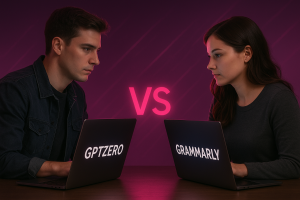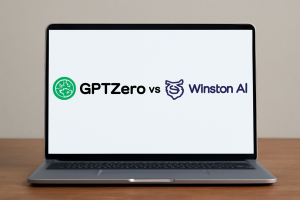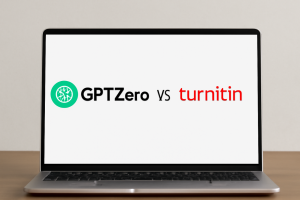Key Takeaways
- GPTZero markets a 98% accuracy in detecting AI-generated content, but these impressive figures often crumble under real-world conditions where human and AI writing blend.
- Copyleaks claims 99.12% accuracy, but independent benchmarking shows closer to 87.5% accuracy when testing different types of AI-human content.
- Both platforms serve different needs: GPTZero is ideal for educators and students, while Copyleaks offers more robust enterprise integrations.
- High-quality content should be the standard assessment and not unreliable detectors, as AI detection constantly lags behind writing tools, making accuracy claims outdated.
- AmpiFire’s AmpCast technology focuses on creating high-quality content in 8 different formats, distributed to 300+ platforms for maximum organic reach and engagement.
The AI Detection Showdown
In the rapidly changing world of AI content creation, detection tools have become essential gatekeepers for maintaining authenticity and academic integrity.
GPTZero and Copyleaks have emerged as leading solutions in this space, each employing sophisticated algorithms designed to identify machine-generated text.
But the big question is; are these tools really reliable?
The AI Detection Mirage
As AI writing capabilities advance at breakneck speed, the line between human and machine-authored content grows increasingly blurred.
- For educators, this presents challenges in evaluating student work authentically.
- For publishers, it raises questions about content originality and value.
- For businesses, it creates concerns about brand voice consistency and intellectual property.
While AI detection tools promote technical-sounding concepts like “perplexity” and “burstiness” analysis in distinguishing AI content from human writing, they all have fundamental limitations: they’re making educated guesses about linguistic patterns that increasingly overlap between human and AI writing.
The reality is that as AI writing improves, these detection methods become less reliable, not more.
The stakes become dangerously high in academic settings where students face accusations based on faulty detection. In content marketing, false positives waste resources and damage relationships. Publishers risk wrongly flagging original content, while businesses make flawed decisions about content authenticity based on unreliable assessments.
This is why content quality should remain the first and foremost standard when judging a content, not AI scores.
How AmpiFire Works:
- Research & Target: Find high-demand topics your buyers search for
- Create & Repurpose: AmpiFire’s AmpCastAI generates news articles, blogs, videos, podcasts, infographics, slideshows, and social posts
- Distribute & Amplify: Auto-publish to 300+ sites including Google News, YouTube, Spotify, and major news networks
Get more traffic from people who want to buy your stuff, and powerful “As Seen On” trust badges for your site.
Do It Yourself (with AI), Done For You Content, & 100% Managed Organic Growth options available.
Grow Your Free Traffic From Everywhere
GPTZero’s Capabilities
GPTZero was originally developed with educators and students in mind, but has expanded to serve content creators, publishers, and businesses concerned with content authenticity. What distinguishes GPTZero is its educational approach—aiming to demystify AI rather than simply police it.
Core Detection Features
At its foundation, GPTZero examines linguistic patterns, sentence structure variability, and word choice predictability for telltale signs of AI generation.
Each paragraph receives individual scoring, allowing users to identify specific sections that may contain AI-generated content rather than making only document-level assessments.
Target Users
GPTZero’s primary audience includes educators worried about academic integrity and students seeking to validate their work as human-generated. Teachers can quickly scan submitted assignments to identify potential AI usage, while students gain confidence that their original work won’t be falsely flagged.
The platform’s educational focus means its interface and feedback are designed with these users in mind, providing contextual information rather than simple binary judgments.
Writers and content creators is another key user segment. For journalists, authors, and marketers concerned about maintaining an authentic voice and originality, GPTZero offers peace of mind by confirming content authenticity.
Copyleaks’ Tech Arsenal
Copyleaks goes with a more tech-heavy approach to catching AI content—using advanced machine learning that’s been trained on massive amounts of both human and AI writing. It really shines in big companies where you need to check tons of content systematically.
Its detection mechanisms are constantly updated to keep pace with evolving AI writing technologies, making it a robust solution for organizations with ongoing detection needs.
Detection Mechanisms
Copyleaks uses a multi-layered approach to AI content detection that analyzes linguistic patterns, syntax structures, and statistical anomalies characteristic of machine-generated text. The system can identify content created by various AI models, including GPT-3 and GPT-4.
By examining hundreds of textual features simultaneously, Copyleaks builds a comprehensive profile of each document to determine its likely origin.
Integration Options
Copyleaks is super flexible if you need to plug AI detection into what you’re already using. Their API lets you access all the detection features programmatically, while ready-made plugins work with popular platforms like Canvas, Moodle, and Microsoft Teams.
They’ve also got solid documentation, SDKs for different programming languages, and developer support to help with custom setups. This technical depth makes Copyleaks perfect for organizations that have specific compliance needs or unique workflows that require customized detection solutions.
Accuracy Face-Off
Accuracy of GPTZero
GPTZero’s performance varies significantly depending on what type of content it’s analyzing. When testing AI-generated casual blog content, GPTZero correctly identified them as artificial only 84% of the time. Additional testing by ZDNet revealed similar reliability concerns, with GPTZero achieving 80% accuracy across five different text samples.
More troubling, the ZDNet analysis found that GPTZero’s performance appears to be declining over time. Text that GPTZero had previously correctly identified as human-written in earlier tests was later flagged as AI-generated when tested again with the same content, suggesting inconsistent results even on identical material.
The good news is, GPTZero performs much better when analyzing human-written content. The platform correctly identified human writing as authentic 96.7% of the time, rarely making false accusations against real authors. Despite this win, our testing shows GPTZero also has a high false negative rate of 35%, meaning that roughly one in three pieces of AI-generated content will slip past the detector unnoticed.
Accuracy of Copyleaks
Based on multiple independent studies, Copyleaks’ AI detection accuracy varies dramatically depending on testing conditions and content types. A comprehensive university study found Copyleaks performed best among eight detectors tested, achieving 99.12% accuracy on human content and 95% on ChatGPT-generated content.
However, even this optimistic assessment showed substantial vulnerabilities, with accuracy dropping to just 50% when content was paraphrased using tools like QuillBot.
Independent testing across multiple organizations paints an even more concerning picture. ZDNet testing found 80% accuracy across five text samples, while Webspero’s comprehensive analysis found Copyleaks achieved only 53.4% overall accuracy.
The false positive and false negative rates from Webspero’s testing expose the tool’s fundamental unreliability. During initial twenty-sample testing, Copyleaks generated a shocking 40% false positive rate, incorrectly flagging four out of ten genuinely human-written pieces as AI-generated content. The false negative rate stood at 20%, meaning one in five AI-generated texts successfully evaded detection by being misclassified as human-written.
These error rates create serious practical consequences. False positives damage relationships with legitimate content creators who face wrongful accusations of using AI, while false negatives allow actual AI content to slip through undetected.
Pricing Comparison
GPTzero Pricing
GPTZero offers a generous free tier that allows users to check a limited number of documents per month without requiring registration. This level provides basic AI detection capabilities with an overall score and highlighted sections, but lacks the more advanced reporting features of paid plans.
Copyleaks Pricing
Copyleaks offers two plans for single users: the AI detector only plan which is $9.99 per month and the AI detector plus plagiarism checker plan, which starts at $16 per month.

GPTZero vs. Copyleaks Comparison Table
| Aspect | GPTZero | Copyleaks |
| Primary Focus | Educational writing assessment, demystifying AI, and content authenticity | Technical AI detection, large-scale content verification, enterprise integration |
| Core Detection Features | Analyzes linguistic patterns, sentence variability, and word predictability; paragraph-level scoring | Multi-layered analysis of linguistic patterns, syntax, and statistical anomalies; identifies content from specific AI models |
| Accuracy (AI Detection) | 80–84% on AI content; 96.7% on human content; high false negative rate (~35%) | Varies: 53–99% depending on study and content; 99% on human, 95% on ChatGPT (best case); high false positive (up to 40%) and false negative (20%) rates in some tests |
| Consistency | Sometimes inconsistent; can give different results on the same content over time | Inconsistent with paraphrased or manipulated content; performance drops with non-English or edited AI content |
| Best Use Cases | Academic integrity, classroom assignments, individual writers, and content authenticity | High-volume enterprise verification, legal compliance, and automated CMS/LMS integration |
| Strengths | Educational feedback, low false positives, paragraph-level analysis, and user-friendly | API/integration flexibility, batch processing, multi-language support, detailed audit trails |
| Weaknesses | High false negatives, inconsistent detection, and limited integration options | High false positives/negatives in some scenarios, inconsistent with paraphrased/mixed content, unreliable for non-English |
Build Quality Content That Drives Results With AmpCast
While businesses waste time worrying about AI detection tools and their accuracy limitations, smart companies focus on what really matters: creating high-quality content that connects with their audience and drives real traffic.
The endless debate about detection accuracy misses the bigger picture; platforms like Google, YouTube, and Spotify care about content quality and user engagement, not whether AI was involved in the creation process.
Our AmpCast platform solves this by helping you to create genuinely valuable content efficiently. The AI technology transforms any topic into 8 different content formats (e.g., news articles, blog posts, infographics, slideshows, interview podcasts, long-form videos, social posts, and short-form videos) then distributes them across 300+ high-authority sites, including Google News, YouTube, Spotify, Pinterest, and major news networks.
This means business owners can stop spending countless hours creating content and then worrying about AI detection. Instead, they can focus on strategic activities like building client relationships, developing new products, and growing their business. Let AmpCast handle the heavy lifting of quality content production and distribution.
Frequently Asked Questions (FAQ)
How accurate are AI detectors like GPTZero and Copyleaks?
Current AI detection technology typically achieves 50–84% accuracy, depending on the specific content type, AI model used for generation, and whether the content has been edited after generation.
GPTZero consistently demonstrates approximately 80% accuracy across diverse testing scenarios, while Copyleaks claims 99.12% accuracy but shows closer to 60% in independent testing with mixed content.
Can these tools detect content from all AI writing tools?
Both GPTZero and Copyleaks can identify content from major AI writing platforms, including ChatGPT, GPT-4, Claude, Bard, and similar large language models with varying degrees of accuracy.
However, neither can guarantee detection of content from all AI systems, particularly those using newer techniques specifically designed to evade detection or specialized models trained on niche domains with unique linguistic patterns.
What happens if the text is edited after AI generation?
Editing AI-generated text typically reduces detection accuracy for both platforms, though to different degrees. Minor edits like formatting changes or simple word substitutions generally don’t significantly impact detection rates.
But substantial rewrites, especially those that alter sentence structures or reorganize content flow, can reduce detection accuracy by a lot, depending on the extent of modification.
Are there ways to bypass AI detection?
Various techniques can reduce detection accuracy, including extensive human editing, translation to another language and back, deliberate introduction of grammatical errors, or use of specialized “AI humanizing” tools.
While these methods can sometimes reduce AI scores, they typically also degrade content quality or require significant additional effort that diminishes the efficiency benefits of using AI.
How can businesses avoid the AI detection problem while still using AI for content creation?
The key is focusing on content quality rather than detection avoidance. Quality content that provides real value to readers will perform well regardless of how it’s created.
Using AmpCast technology, you can create high-quality content in 8 different formats: news articles, blog posts, infographics, slideshows, interview podcasts, long-form videos, social posts, and short-form videos.
These contents are automatically distributed across 300+ high-authority sites, including Google News, YouTube, Spotify, Pinterest, and major news networks, building brand recognition and reach.
Author
-

CEO and Co-Founder at AmpiFire. Book a call with the team by clicking the link below.
Related Posts

GPTZero vs ZeroGPT AI Detector Mega Test: Best Accuracy & False Positives?
We tested GPTZero and ChatGPT on dozens of AI- and human-written texts (including casual blogs, short stories, and even political…

GPTZero vs Quillbot AI Detector: Which One Can Detect AI Content More Accurately?
Compare GPTZero and Quillbot AI Detector on accuracy and methods. Discover which tool excels at spotting AI-written content in our…

GPTZero vs Grammarly: AI Detector: Which One Can Detect AI Content Better?
Compare GPTZero and Grammarly's AI detection capabilities. Discover which tool better identifies AI-generated content for your writing needs.

GPTZero vs Winston: Which is the Better AI Detector?
Compare GPTZero vs Winston AI detection accuracy, pricing & features. Discover which AI detector works best for educators vs. marketers…

GPTZero vs Turnitin: Which is the Better AI Detector?
Compare GPTZero vs Turnitin AI detectors with our expert analysis covering accuracy, pricing, and integration to choose the best detection…

Is ChatGPT “Nigerian English”? How AI Detection Is Rigged
Nigerian English, 1980s political speeches, and 19th-century literature have one thing in common: they’re often mistaken for AI.









